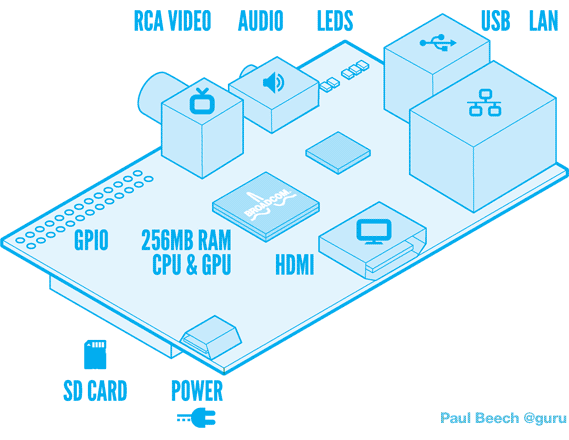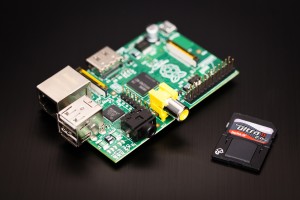
Specifications of Raspberry Pi:
| Model A | Model B | |
|---|---|---|
| Target price: | US$ 25 | US$ 35 |
| SoC: | Broadcom BCM2835 (CPU, GPU, DSP, and SDRAM) | |
| CPU: | 700 MHz ARM1176JZF-S core (ARM11 family) | |
| GPU: | Broadcom VideoCore IV, OpenGL ES 2.0, 1080p30 h.264/MPEG-4 AVC high-profile decoder | |
| Memory (SDRAM): | 256 MB (shared with GPU) | |
| USB 2.0 ports: | 1 | 2 (via integrated USB hub) |
| Video outputs: | Composite RCA (PAL & NTSC), HDMI (rev 1.3 & 1.4), raw LCD Panels via DSI
14 HDMI resolutions from 640×350 to 1920×1200 plus various PAL and NTSC standards. |
|
| Audio outputs: | 3.5 mm jack, HDMI | |
| Onboard storage: | SD / MMC / SDIO card slot | |
| Onboard network: | None | 10/100 Ethernet (RJ45) |
| Low-level peripherals: | 8 × GPIO, UART, I²C bus, SPI bus with two chip selects, +3.3 V, +5 V, ground |
|
| Power ratings: | 500 mA (2.5 W) | 700 mA (3.5 W) |
| Power source: | 5 volt via MicroUSB or GPIO header | |
| Size: | 85.60 × 53.98 mm (3.370 × 2.125 in) | |
| Weight: | 45 g (1.6 oz)[65] | |
| Planned operating systems: | Debian GNU/Linux, Fedora, Arch Linux ARM, RISC OS | |
Now with this cheap single-board computer, the applications are numerous. We can use this in developing robotics projects, computers, Automation, gaming, Networking, graphics, toys, tabs..etcI have just received my first raspberry pi board. I though of ordering atleast 10 modules for my various projects, but they are not accepting bulk orders yet. So i just got one. with USB ports on the board i have options to add camera and display modules. I am kind of thinking a Tanker kind of robot as my first project. If you got any better ideas do let me know. You can get more info at: http://www.raspberrypi.org/

